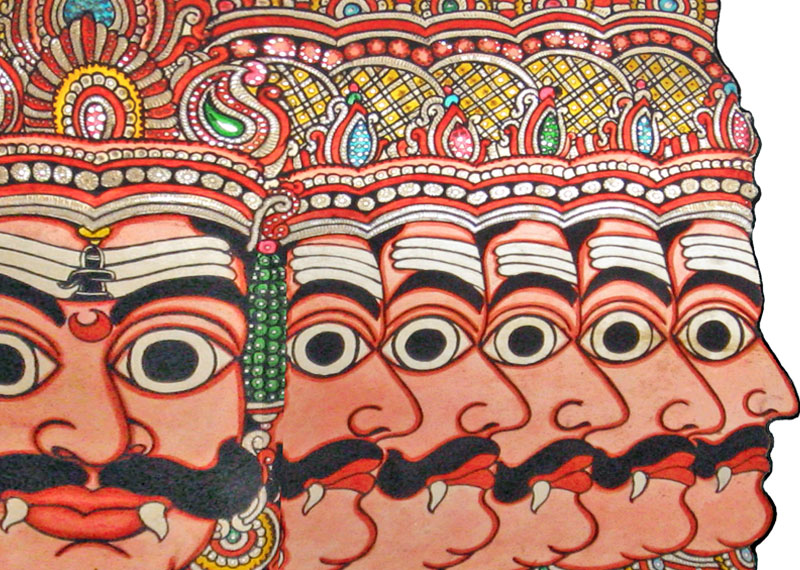If there is one mythological character who has captured the imaginations of the Tamils on a large scale, it has got to be Ravana. Stories of him being a devotee of Lord Shiva are to be found in the Hindu puranas and also in the Nayanmar poems, which incidentally also claim that Lord Ram was a Shiva devotee.
After Robert Caldwell opened a Pandora’s Box by talking about a racial divide among the Indians, an entirely new dimension was introduced to the narrative so as to claim that Ravana was a Dravidian king and that Rama was an Aryan ruler. To this day we can see self-styled historians claiming that the very existence of the Sinhala language in Sri Lanka is the result of the Rama-Ravana war.
In 1946, a whole new book called Ravana Kaaviyam was written in 1946, to project Ravana as the hero and Rama as the villain. The author of the book was Pulavar Kuzhandhai, who had leanings towards the Dravidar Kazhagam, an aetheist movement that was started to challenge the Brahminical dominance.
Such a stream of thought had lost steam over the years, but of late, linguistic chauvinists in the state like Seeman and Thirumurugan Gandhi have picked it up again. We can also see some demands by fringe groups to conduct a Raavan Leela, in response to the Ram Leela.
At the same time, we can also see that the traditionalists and the people of Tamil Nadu at large, have repeatedly questioned these claims and written them off as fake narratives peddled with an ulterior motive to divide society.
With this being the case, it becomes imperative to look into the ancient Tamil scriptures to see which of the claims are substantiated by evidence.
The earliest references to the Ramayana in Sangam Tamil literature is to be found in the text Puranaanooru in the 378th poem.
கடுந்தெறல் இராமன் உடன் புணர் சீதையை
வலித்த கை அரக்கன் வௌவிய ஞான்றை
நிலஞ்சேர் மதர் அணி கண்ட குரங்கின்
செம்முகப் பெருங்கிளை இழை பொலிந்து ஆங்கு
Sita,who was the wife of the ferocious Rama, was kidnapped by the demon Ravana, who had strong arms. Sita threw her ornaments in the vicinity of monkeys who were squatting on the ground. The monkeys, which had reddish faces, were bewildered by seeing the ornaments.
The poet, Onn Podhi Pasingudaiyaar, takes this as a reference to narrate the bewilderment and ecstasy which poets feel when they receive gifts from the Chola King Ilanchet Cenni.
Please note that Ravana is reffered to as a demon and not as a leader of Tamils, anywhere in the poem.
We find another reference to the Ramayana in another Sangam Tamil text, Aganaanooru in the 70th poem.
வென்வேற் கவுரியர் தொன்முது கோடி
முழங்கிரும் பௌவம் இரங்கும் முன்றுறை
வெல்போர் இராமன் அருமறைக்கு அவித்த
பல்வீழ் ஆலம்
Rama, who was victorious in the war, came and sat under a banyan tree in Dhanushkodi, which was ruled by the Pandian Kings, along the sea shore. When Rama was reading his texts, he Banyan tree was engulfed by silence.
This incident is used by the poet as a reference to explain how a village that used to gossip about the love of a Tamil couple, stopped gossiping and became silent once they got married (just as how the Banyan tree was engulfed by silence once Rama sat under it to read his texts).
Note how Rama’s victory over Ravana is celebrated in this poem by calling him as a victorious king.
The very fact that the Ramayana story is not actually narrated, but used as a parable to explain the nature of something else, in both of these poems, is proof of the fact that Ramayana was revered in Tamil Nadu.
We also find various references in the later Tamil texts like Pazhamaozhi Naanooru, Silapathikaaram and Manimeekalai which sing praises of Rama. Nowhere do we find the acts of Ravana, being celebrated or he being referred to as a Tamil King.
Another interesting aspect is that the very name,Ravana,is not a permitted word,as per the rules of Tamil grammer, which state that no word should started with the syllable “Ra”.
The Tamil text Nanool, has the below sutra.
ரவ்விற்கு அம்முதலாம் முக்குறிலும்
லவ்விற்கு இம்முதல் இரண்டும் யவ்விற்கு
இய்யும் மொழிமுதல் ஆகி முன் வருமே
Meaning:The phoenetic “Ra”(ர) should be prefixed with “Ae”(அ)/E(இ)/OU(உ). The phoenetic la(ல) should be prefixed with E(இ)/OU(உ).
This sutra is drawn from the earliest Tamil work, Tholkaapiyam, which defines the rules as to how Sanskrit words in Tamil should be used without violating the rules of Tamil Grammar.
வடசொல்–கிளவி வட எழுத்து ஓரீஇ,
எழுத்தொடு புணர்ந்த சொல் ஆகுமே
Meaning:While writing Sanskrit words in Tamil,they should be modified in such a way that they don’t violate the rules of Tamil grammar.
This is the reason why the Sanskrit word ராவணன் is written as இராவணன் in Tamil, so that the rules of Tamil grammar are not violated.
While today we find Tamils giving Sanskrit names to their children, this was not the case with ancient Tamils. So it becomes amply clear that Ravana did not have Tamil origins.
The Hindu Puranas also claim that Ravana was born in today’s Uttar Pradesh and later settled down in Sri Lanka, thus explaining why he had a Sanskrit name instead of a Tamil one.
Today’s Ravana fanatics like Seeman do have the dubious history of sharing stage with Kashmiri separatists like Yasin Malik, so it is no surprise that they claim that a demon like Ravana is their leader.
If the friendship grows in leaps and bounds, and if the people of Tamil Nadu, were to fall for tricks of such people, we would soon see him assigning new heroes to the Tamil population, based on his own “discoveries”.
Hopefully they don’t call Osama Bin Laden as a ‘muppattan’ (ancestral grandfather).

